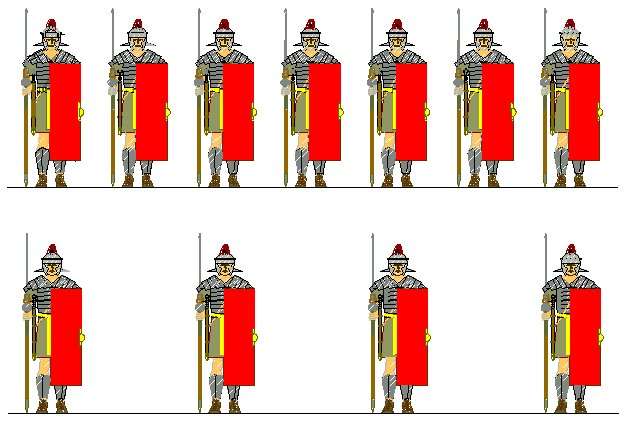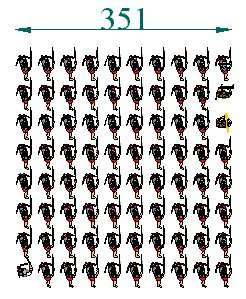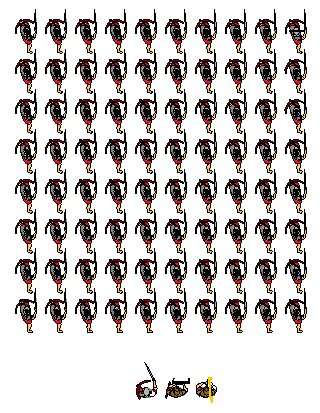The Legion Formation
Considering that the Roman army was arguably the greatest military force the world has known, that pretty good eyewitness descriptions have come down to us and that it has been extensively studied for hundreds of years, it is somewhat amazing that no one really knows exactly how it looked or functioned. This section lays out some of the alternative views about the structure of the legion itself.
The legion being considered is the cohort legion of the late republic and early empire, before the introduction of the enlarged first cohort in the first century AD.
Arrangement of the individuals within the ranks and files
The first question is how close the individual soldiers stood to each other. This has been argued for centuries. It is generally agreed that the ranks were about six feet apart. However, the ancient sources offer two versions of how much lateral space the Roman soldier occupied: three feet or six feet. Suffice to say that current thinking seems to be in favor of a three-foot spacing. Both spacings are illustrated below.
Overall, three feet seems more reasonable. Six feet just seems too widely spaced, leaving the individual too vulnerable to attack.
Arrangement of the ranks and files in the century
This was also discussed in the chapters The Spacing of the Individual Soldiers and Description of the Century and Maniple on the original webpage.
The nominal century, one at full strength, had about eighty men in it. I am not aware that there is any consensus about how the centurion, optio, signifer, and cornicen or tubicen are to be counted. They could be included in the eighty, or the number could be as high as 84.
There is no consensus about how the century was arranged in terms of ranks and files. Different authors give numbers ranging from 3 ranks by 27 files (Goldsworthy) to a high of eight ranks and ten files (Connolly). In between, I believe I have seen arrangements for every combination of ranks and files except for seven ranks deep. Dr. Sabin thinks that the centuries may have been only three or four ranks deep if they were aligned one behind the other to give an overall depth of six to eight ranks. Configurations of 3 by 27 and 8 by 10 are illustrated below.

There is one piece of ancient evidence that may help. Caesar mentions that the ridge at Ilerda was just wide enough for three cohorts to deploy in battle formation. Peter Connolly has visited the ridge and measured it. He found the ridge to be between 150 and 170 meters wide. Taking an average of 160 meters for the ridge, it would hold about 173 men on three-foot intervals. That would make each cohort about 58 files wide. Connolly's cohort of eight ranks and sixty files would fit rather nicely into this space. Goldsworthy's cohort of 3 ranks by 160 files would not fit onto the ridge.
It would certainly be reasonable to use Connolly's configuration of eight ranks by ten files as a kind of parade-ground formation.
Beyond that, there are two other considerations that could change the configuration: units being under strength and the circumstances of a particular battle.
Units were always under strength. It is a maxim of all military organizations, apparently in all ages, that the number of men available on any given day is always less, and sometimes much less, than the nominal strength. In the case of a Roman army in the field, the number of active men would be immediately reduced by illness and injury. During the course of a campaign, the unit strength would be depleted by casualties and at times reinforced by new recruits. During combat, the later legions, at least, may have withdrawn some few men for special duty such as manning the artillery. The true strength of a unit could be as little as half its nominal strength.
The formation could be adjusted for missing men by reducing either the number of ranks or the number of files. Which alternative is chosen depends on which one thinks was more critical, to preserve the length of the front or to preserve the depth of the formation?
In favor of preserving the length of the front is that the legion formation itself would be more standard that way. Each century and cohort and legion would always take up a certain amount of frontage, regardless of manpower. This would make it easier for other centuries and cohorts to know where they should align themselves.
In favor of preserving the depth of the formation is that a depth of around eight ranks seems to be fairly consistent in ancient armies. If there was not some value to depth, then why not extend the line as far as possible to overlap the enemy line? Yet ancient armies, Rome included, did not do this. Therefore it seems likely that experience had proven the value of a certain depth to the formation.
In support of this is a possible example at Pharsalus. Caesar notes that the 8th and 9th legions on his left flank were so depleted that he ordered them to draw close to each other so as to almost form a single legion:
Caesar superius institutum servans decimam legionem in dextro cornu, nonam in sinistro collocaverat, tametsi erat Dyrrachinis proeliis vehementer attenuata, et huic sic adiunxit octavam, ut paene unam ex duabus efficeret. [De Bello Civili 3.89]
If each legion maintained a fixed front, regardless of manpower, then the joining of the 8th and 9th would involve one legion drawing up behind the other. This is not the impression gained from the text. Rather, it seems to imply that the two legions drew close together, side by side, so as to almost make one of two.
It may not be possible to fully resolve this question. We simply have too little information. However, the account of Pharsalus does offer a way to resolve the question.
Pompey's strength is given as 45,000 men. We are told that he arranged his men ten ranks deep [3.88]. Caesar's strength was 22,000 [3.89]. Since there is no mention in the account of Pompey's army outflanking Caesar's it appears that the front of both armies was about the same. For Caesar to have matched Pompey's front his line would have had a depth of about five men. There are other examples where the battle formation was decided in advance by the general (the battles of Cannae and Zama come to mind).
What may have happened is that the general would assess his overall strength, quality of his soldiers, character of the enemy, terrain involved, and whatever other conditions he factored into his plan of battle and then decide in advance how long and deep a front he would deploy. That line depth would then be more or less constant for the entire length of the front. In other words, the number of ranks would not vary significantly from one century to the next. In this way, the general would adjust his formation to meet the needs of the particular battle and determine how long and deep his formation could be or needed to be. Each century would then deploy itself into the number of ranks ordered by the general. Different centuries might occupy different fronts depending on their total manpower.
As an interesting aside on the subject of ranks and files, Ron Hauser, a reenactor, writes: "The structure of a unit, we have found, is defined by its depth. Four or more rank deep units function well as heavy infantry. If a unit is thinned to three or two ranks, it becomes a skirmish unit, regardless of the desire of its members or officers. So it makes sense that the scaling of cohorts would be by files to maintain the character of the unit." Modern reenactors cannot duplicate conditions in the Roman army, but their experience may provide insight here and there.
Position of the officers in the century
The location of the centurion seems fairly certain. He led from the right side of the formation. Some illustrations show him in a file by himself. This may have worked in a parade ground formation but in battle, it seems much more likely that he led from the first rank of the first file.
Each century also had an optio (a second in command), a signifer (who carried the standard of the century), and an aeneator, either a tubicen or a cornicen (who conveyed orders on his horn). The optio (in Warry, for example) seems to have been stationed at the back. Some place him in the last rank and the last file on the left, diagonally opposite the centurion. Goldsworthy, I believe, has him somewhere behind the unit, patrolling the area, being sure no one tries to turn and flee.
The location of the signifer is a matter of discussion. Some put the signiferi behind the formations, others seem to think the standards were right up front, leading the way. There seems to be some indirect evidence for locating the standards in the front insofar as it is clear that they were rallying and assembly points. However, it seems unlikely that the most prized possession of the century would be put in the front. It seems almost incredible that the century would go into battle with a man in the foremost ranks who could not fight, could not even protect himself. Somehow it makes much more sense to locate the standard somewhere behind the century. If the standards were in this position it would make it easier for dispatch riders from the general or tribunes to find the appropriate units.
The position of the aeneator is usually ignored. Many illustrations show him next to the centurion. In this position, he would be able to receive orders from the centurion and then signal them to the rest of the unit. However, the same concerns as were voiced about the signifer apply here too. The man could not defend himself, what business would he have in the thick of the fighting. Warry shows both the signifer and aeneator behind the unit.
It would make a certain amount of sense if the optio, signifer, and aeneator, were all together somewhere just behind the unit. The optio could keep order and would be there to receive and relay orders from his superiors. The standards would provide a ready reference point for those needing to locate the optio. And the aeneator might be heard better since he would be more central and would be directing his horn signals toward the century no away from it.
The illustrations above show the signifer and aeneator directly behind the centurion and the optio in the last rank of the left file. The illustration below shows the optio, signifer, and aeneator behind the century in what may be a more plausible arrangement.
Position of the centuries in the cohort
The centuries were associated in pairs identified as prior and posterior. These designations would seem to indicate that one century was aligned behind the other. The traditional representations of the legion formation usually show them in this configuration. However, having one century behind the other presents some difficulties. For the posterior century to be an effective fighting force it would have to somehow replace the prior century. This introduces some of the same problems that line replacement faces.
J. C. Mann's study 'Roman Legionary Centurial Symbols' (ZPE 115, 1997) seems to support a front to back arrangement. The six symbols are:
_____| ____|____ |______
______ ________ ______
| | |
Mann feels that this configuration clearly reflects the six centuries in battle order.
Hastatus Prior - Princips Prior - Pilus Prior
Hastatus Posterior - Princeps Posterior - Pilus Posterior
However, he also describes how the line of march of these same six centuries would also reflect the front to back relationship with pilus Prior leading pilus Posterior and so forth.
Configurations that have the centuries front to back usually favor fewer ranks so that the two centuries together total about eight or ten ranks. Configurations that place them side by side (except Goldsworthy) usually represent the formation as deeper, again around eight ranks. The two formations are, in a way, roughly equivalent.
Opinion seems to be moving toward favoring the side by side formation. The title prior and posterior are then taken to be either some kind of anachronism or as referring to the order of march.
In either case, since the two alternatives are roughly similar, it may not make a critical difference in understanding the legion.
The traditional formation for the legion is illustrated below.
This is the formation usually seen in illustrations of the legion formation. The centuries are arranged front to back, three pairs per century. The cohorts are separated by a gap equal to the width of the cohort so that the second line of cohorts could move through the gaps during line replacement. The three lines are separated by about 250 feet.
There are several problems with this configuration. Today almost no one would have the legion going into battle with gaps of 100 feet in the front line. Another difficulty is that each cohort takes up a front of 98 feet, but the data from Ilerda would indicate a cohort front of about 173 feet. And, as noted above, having one century behind the other complicates the understanding of how the centuries actually fought.
The next illustration shows basically the same formation with the centuries lines up side by side to close the gaps.
(Note: all of the illustrations of the legion formations are represented at the same scale.)
In this representation each cohort has a front of about 236 feet, a bit more than Ilerda would indicate. However it would be possible if one assumes that Caesar was referring not to three cohorts of nominal strength but to three of his actual cohorts which were quite possibly under strength.
If each soldier were spaced six feet instead of three feet apart then the width of the formation would double. That is illustrated in the next image.
There are two major problems with this configuration. As discussed above, it does not seem adequate to have only one man every six feet. The other concern is the overall length of the front. Each legion would take up almost 1/3 of a mile. Larger armies such as those used in the civil wars, eight legions, sometimes more, would have a front almost 14,000 feet, nearly three miles, wide. The plain at Pharsalus where Caesar's eight legions met Pompey's eleven legions plus 7,000 cavalry was about 10,000 feet wide where prevailing opinion sites the battle, 16,000 feet at the very widest part.
The problem of length is worse if the legion were only three ranks deep, as Goldsworthy suggested.
A formation somewhat similar to the second one above, but with some important differences, is shown below.
This is a formation favored by Dr. Philip Sabin which he refers to as a dogtooth formation. Sabin's reference is, I believe, to the maniple legion formation but if it were applied to the cohort legion the above illustration is what it would look like. The centuries are shown as eight ranks by ten files, as illustrated above. The centuries are lined up side by side in this illustration, though in his thinking they could be front to back with fewer ranks, so that a pair would take up roughly the same space in either arrangement. The second line is quite close to the action. In this case it is held back a mere 50 feet. The proximity of the second line prevents incursions into the gaps. The gaps allow for line replacement. The third line is held further back as a true reserve.
The problems still to be resolved in this scenario are how line replacement might have worked without asking large groups of men to march backwards. A feat that Delbruck proved impossible. However, line replacement is difficult to understand no matter how one configures the legion, so that may not be a valid criticism of this particular model.
At almost 1,600 feet per legion, it would be difficult to fit Pompey's army of eleven legions and 7,000 horse onto the plain of Pharsalus. Pompey's centuries were ten ranks deep, 25% deeper than those depicted. But his legions were nearly at full strength. If the width were reduced 30% to account for the deeper formation and for missing men, the front for each legion would be 1,100 feet. Pompey's eleven legions would take up 12,000 feet. There would be only one place on the plain of Pharsalus wide enough to hold that army, and there are, apparently, problems in reconciling that location with details in the text.
The final image is similar to the formation above but without the gaps.
This formation has the merit of not offering gaps to the enemy. The second line is close to the front to support it. However, without gaps there is no real possibility of line replacement happening. Exactly how the second line might support the first without gaps is not easy to imaging either.
The individual cohorts of this formation, and the one above, each have a front of about 200 feet, a bit wider than the 173 feet suggested by Ilerda but, perhaps, within a reasonable margin of error.
If the same adjustments made above are applied here, reducing the width by 30%, then each legion would have a front of 623 feet, Pompey's elevent legions take up 6,850 feet, leaving a bit over 2,000 feet for the cavalry.
